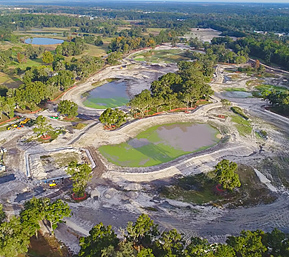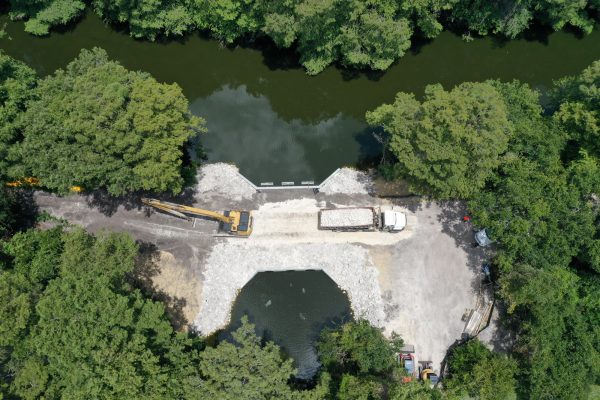Implementation projects to improve the health of Florida’s springs and their ecosystems are a major component of the St. Johns River Water Management District’s core missions work. These projects support springs restoration in many ways. One of the more common types of projects involves the expanded use of reclaimed water to decrease nitrate pollution. This is accomplished by reducing or eliminating direct wastewater discharges and using this water to replace other irrigation sources, so that nutrient uptake and substantial reductions can occur in the irrigated turf or other plants. Reclaimed water projects also protect spring flows by reducing demand for surface and groundwater withdrawals.
Since 2014, more than 153 projects protecting spring water flow and water quality have been funded through District cost-share programs. The District has contributed nearly $59 million toward vital springs projection projects, resulting in 50 million gallons per day (mgd) alternative water supplied, 14 million gallons in alternative water storage capacity created, and 5 million gallons of water a day (mgd) conserved. These projects also have reduced total nitrogen to priority spring systems by over 1 million lbs/yr and total phosphorus by 144,000 lbs/yr.
Project spotlight
Orange County Utilities (OCU) Wekiwa Springs Septic Tank Retrofit Phases 1 and 2
The multi-phased project includes construction of a sanitary sewer main, laterals, sewer connections, lift stations, and septic tank abandonment for 367 parcels in the Sweetwater West, Wekiva Highlands, and Palms 1 and 2 neighborhoods, which are adjacent to Wekiwa Springs State Park. The estimated nutrient load reduction water quality benefit to the Wekiwa-Rock springshed is 8,646 lbs./yr. TN. Construction cost: $47.7 million. District/DEP Cost-share: $13.1 million. The first four phases are part of a multi-year strategy to abandon and replace up to more than 900 septic tanks in 20 neighborhoods in the immediate vicinity, and to connect those residents to OCU’s sanitary sewer service.
Ocala Pine Oaks Wetland Recharge Park
The completed project involved the construction of a 33-acre groundwater recharge wetland that receives advanced treated wastewater from the city’s Water Reclamation facilities (WRF) #2, #3, and stormwater from the Old City Yard Drainage Retention Area. The project provides 3 to 5 million gallons per day of recharge to the Upper Floridan aquifer, which is of significant benefit to Silver Springs flows, and also provides water quality improvements via wetland polishing of the advanced treated wastewater. The estimated nutrient load reduction water quality benefit is 59,000 lbs./yr. TN and 30,000 lbs./yr. TP. Construction cost: $8,362,766. District/DEP Cost-share: $4,000,000.

Volusia County advanced wastewater treatment (AWT) for the protection of Blue Spring
The completed project involved expansion in capacity and improvement in treatment level to increase nitrogen removal from the Volusia County Southwest Regional Water Reclamation Facility (WRF). The project included decommissioning of the Four Towns Wastewater Package Plant, with those flows being redirected to the Southwest Regional WRF AWT treatment. The estimated nutrient load reduction water quality benefit is 27,000 lbs./yr. total nitrogen (TN) and 14,000 lbs./yr. total phosphorous (TP). Construction Cost: $12,129,500. District/DEP Cost-share: $7,257,500.
Altamonte Springs regional water reclamation facility process improvements for advanced wastewater treatment
The Altamonte Springs Regional Water Reclamation Facility (ASRWRF) is an award-winning water reclamation plant designed to provide treatment for up to 12 million gallons per day of wastewater from several municipalities. Located in central Florida, the project directly benefits the Little Wekiva River and the Wekiva River Basin in general. The project consists of treatment process improvements from secondary to advanced wastewater treatment standards and nutrient effluent concentrations to 3 milligrams per liter for total nitrogen and 1 milligram per liter for total phosphorus.
Paynes Prairie diversion structure replacement — Aquifer recharge
The District completed work in mid-2019 on a new water control structure that is key to controlling water into Paynes Prairie, which in turn affects flow into the Alachua Sink. This project includes multiple benefits, providing significant ecological benefits to the prairie, recharging the Floridan aquifer via Alachua Sink, which can increase water supplies and enhance spring flows, and offering some flood protection for U.S. 441 during major flood events. The $788,000 project replaced a failing 40-year-old structure with an operable structure, including three new 54-inch aluminum culverts, gates, concrete headwalls and upgraded guardrails, handrails and fencing.


